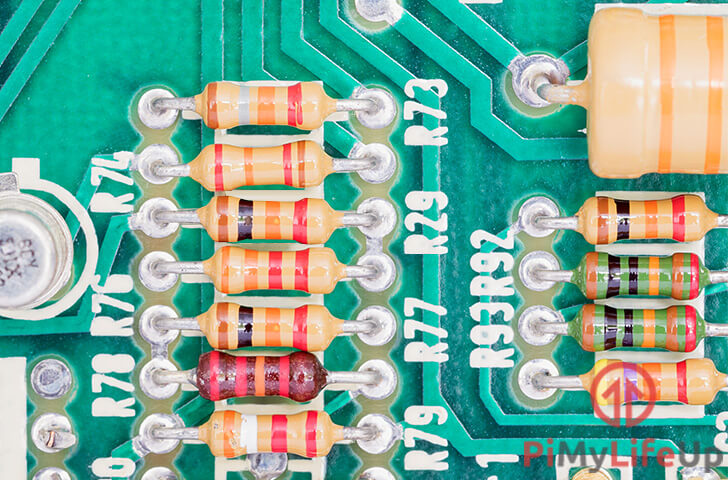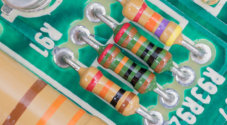In this resistor color code guide, we will be showing you how to interpret the value of a resistor based on the color of the bands.

Knowing how to recognize the value of a resistor quickly is an extremely handy skill to have in electronics as it will save you a lot of time.
We have included a resistor color code calculator so you can quickly work out the value of your resistor. It’s also handy for verifying that you’re purchasing the correct resistors for your next project.
You should find this guide handy if you’re new to electronics and you’re tackling some of our Arduino projects or the Pi projects that involve circuitry.
What is the Color Code for Resistors?
The resistor color code is the way of working out the values of a resistor. Almost all leaded resistors that have a power rating of 1 watt or less will come with a color code printed on it.
A resistor can feature up to 6 different color bands. Together these color bands specify the attributes of that resistor. These attributes include the base resistance value, the resistance multiplier, the tolerance, and also the temperature coefficient.
At a bare minimum, the resistor color guide requires two bands. One band indicating a resistance value and the other specifying the multiplier. Typically, however, you will find most resistors make use of the 4-band or 6-band color code system.
This resistor color code is defined as an international standard by the International Electrotechnical Commission under the IEC 60062 publication.
The standard specifies all the markings that can be used for resistors and capacitors. In addition to the color code system, there is also a numerical system that is primarily utilized for SMD resistors.
In addition to specifying the markings, the actual resistance values of resistors are standardized. These standardized values are called “Preferred values” or “E-Series” resistors.
Resistor Color Code Calculator
Our resistor color code calculator is a fast and straightforward way of working out the value of any resistor. There are some instructions on how to use the calculator directly underneath it.
To use our simple resistor color code calculator, all you need to do is use the drop-down boxes to select the color of each band on the resistor.
The calculator will automatically work out all the values of your resistor on the fly.
The Resistor Color Code
Below we have included a table to show the difference between a 4-band, 5-band, and 6-band resistor.
You will notice that the only real big difference is between the 4-band and 5-band resistors. The 5-band resistor has another band that helps represent the number.
This extra digit band helps when declaring larger resistors and having more precise values when compared against the 4-band resistor.
The 6-band resistor is just like the 5-band resistor but has an additional band that is utilized to show the temperature coefficient.
Resistor Bands
| Bands | 4 Band Resistor | 5 Band Resistor | 6 Band Resistor |
|---|---|---|---|
| 1st | 1st Digit | 1st Digit | 1st Digit |
| 2nd | 2nd Digit | 2nd Digit | 2nd Digit |
| 3rd | Multiplier | 3rd Digit | 3rd Digit |
| 4th | Tolerance | Multiplier | Multiplier |
| 5th | Not Applicable | Tolerance | Tolerance |
| 6th | Not Applicable | Not Applicable | Temperature Coefficient |
Digit Bands
The digits bands are the first three color bands on a 5-band resistor and the first two bands on a 4-band resistor.
These bands are used to indicate the resistance value of that resistor. Each color represents a number ranging from 0 – 9.
Using our table below, you can see which color represents a certain number. Underneath the graph, we show you an example of how to use it to calculate the resistance of the resistor.
| Color | Digit |
|---|---|
| Black (Only on 2nd and 3rd Bands) | 0 |
| Brown | 1 |
| Red | 2 |
| Orange | 3 |
| Yellow | 4 |
| Green | 5 |
| Blue | 6 |
| Violet | 7 |
| Grey | 8 |
| White | 9 |
For example, using the tables on this page with a 5-band resistor, we can work out what the value is of the first three digits.
Using a Red Brown Black Brown Brown resistor, we can work out that the base resistance value before the multiplier is applied is 210 Ω.
| 1st Digit | 2nd Digit | 3rd Digit | Multiplier | Tolerance |
|---|---|---|---|---|
| Red | Brown | Black | Brown | Brown |
| 2 | 1 | 0 | x 10 | ±1% |
Multiplier Band
The multiplier band is the third band on a three-color band and the fourth band on a 5 and 6 band resistor.
This band is used to gain the real resistance value of the resistor.
The value retrieved from the digit bands on a resistor is multiplied by the multiplier band to calculate the actual resistance value of the resistor.
Based on our example used in the Digit Bands section, we multiply our base 210 Ω value with our multiplier, which was x 10.
The multiplier value means the actual resistance value of our example resistor is 2.10K Ω.
| Color | Value |
|---|---|
| Black | x 1 |
| Brown | x 10 |
| Red | x 100 |
| Orange | x 1,000 |
| Yellow | x 10,000 |
| Green | x 100,000 |
| Blue | x 1,000,000 |
| Violet | x 10,000,000 |
| Grey | x 100,000,000 |
| White | x 1,000,000,000 |
| Silver | ÷ 10 |
| Gold | ÷ 100 |
Tolerance Band
The tolerance band is the fourth band on a 4-band resistor and the fifth band on a 5-band and 6-band resistor.
Tolerance on a resistor indicates how much more or less you can expect from the stated resistance.
For example, a 2.10K Ω resistor with a tolerance of ±1% would have a minimum resistance of 2.079K Ω and a maximum resistance of 2.121K Ω.
| Color | Value |
|---|---|
| Brown | ±1% |
| Red | ±2% |
| Orange | ±3% |
| Yellow | ±4% |
| Green | ±0.5% |
| Blue | ±0.25% |
| Violet | ±0.10% |
| Grey | ±0.05% |
| Silver | ±5% |
| Gold | ±10% |
You can calculate the maximum and minimum resistance for any resistor with a tolerance band using some simple math.
First, let’s say tolerance_percentage is equal to the tolerance value on the resistor. In the case of our example resistor (Red Brown Black Brown Brown), this is 1%.
tolerance_percentage = 1Next, we need to convert our tolerance value from a percentage to the decimal system by dividing the value by 100. We will call this value tolerance.
tolerance = tolerance_percentage / 100
tolerance = 1 / 100
tolerance = 0.01Next, we say resistance is equal to the resistance of the resistor, which in our example, this is 2.10k. We can omit the “K” from the actual math.
resistance = 2.10Now that we have the tolerance as a decimal and have the resistance value down as resistance, we need to multiply these together to work out the percentage this makes up of the resistance value.
We will call this value resistance_tolerance.
resistance_tolerance = resistance / tolerance
resistance_tolerance = 2.10 x 0.01
resistance_tolerance = 0.021
Now that we have our resistance tolerance percentage as a value, we can easily calculate the maximum and minimum resistance values by using some simple addition and subtraction.
minimum_resistance = resistance - resistance_tolerance
minimum_resistance = 2.10 - 0.021
minimum_resistance = 2.079
maximum_resistance = resistance + resistance_tolerance
maximum_resistance = 2.10 + 0.021
maximum_resistance = 2.121
Temperature Coefficient
The temperature coefficient (Sometimes referred to as “Tempco”) is the 6th band on a 6-band resistor.
This band defines the change in resistance as the ambient temperature changes.
| Color | Value |
|---|---|
| Brown | 100 ppm/°C |
| Red | 50 ppm/°C |
| Orange | 15 ppm/°C |
| Yellow | 25 ppm/°C |
| Blue | 10 ppm/°C |
| Violet | 5 ppm/°C |
Resistor Color Code Examples
In this section, we are going to go through three sample resistors. There is a sample for a 4-band resistor, 5-band resistor, and a 6-band resistor.
We will decode the color code of each resistor sample, and show how we worked out each value.
4-Band Resistor
The first resistor that we are going to delve into is a 4-band resistor. This resistor is the simplest to decode as it has the least amount of bands.

To start, we will match each color band to its value. Using the simple table below, we can fill in the data from our tables above.
| 1st Digit | 2nd Digit | Multiplier | Tolerance |
|---|---|---|---|
| Green | Green | Brown | Silver |
| 5 | 5 | x 10 | ±5% |
Calculating the 4-band resistors resistance
From the resistors color bands and multiplier, we can calculate the actual resistance of our sample 4-band resistor.
The base resistance gathered from the two-digit bands, Green and Green is 55.
base_resistance = 55To get the actual value of our resistor, we need to multiply the value gathered from the digit bands with our multiplier band.
From the Brown multiplier band, we know we need to multiply our base resistance value by 10.
multiplier = 10Using these two values, we can work out that our sample resistor has a resistance of 550 ohms.
resistance = base_resistance * multiplier
resistance = 55 * 10
resistance = 550Calculating the 4-band resistors tolerance
Calculating the tolerance for a resistor is simple. All you need is the final resistance value from the previous step and the value from the tolerance band of the resistor. We will write this value down as our resistance.
resistance = 550Now we need to convert our tolerance from a percentage to a decimal. We can do that by just dividing it by 100. We know from the “silver” color band on the resistor that the tolerance of this resistor is “5%”.
tolerance = tolerance_percentage / 100
tolerance = 5 / 100
tolerance = 0.05With our tolerance converted to a decimal, we now need to work out the percentage that the tolerance makes up of our resistor. We will call this resistance_tolerance and can calculate it by dividing our resistance by our decimal tolerance value.
resistance_tolerance = resistance x tolerance
resistance_tolerance = 550 x 0.05
resistance_tolerance = 27.5Now that we have calculated the deviation amount for our resistors tolerance, we can calculate what the maximum and minimum tolerances are for our resistor.
This math is simple as subtracting and adding our resistance_tolerance calculation to our base resistance value.
minimum_resistance = resistance - resistance_tolerance
minimum_resistance = 550 - 27.5
minimum_resistance = 522.5
maximum_resistance = resistance + resistance_tolerance
maximum_resistance = 550 + 27.5
maximum_resistance = 577.5With our math done, we now know that with a 5% tolerance our 550 ohm resistor has a minimum resistance of 522.5 ohms and a maximum possible resistance of 577.5 ohms.
5-Band Resistor
Our second example resistor showcases a 5-band color resistor. The main difference between this resistor and the 4-band resistor is the addition of the 3rd digit.

Again using the tables above or the resistor color code calculator, you can quickly work out the value for each color band of the resistor.
| 1st Digit | 2nd Digit | 3rd Digit | Multiplier | Tolerance |
|---|---|---|---|---|
| Brown | Black | Black | Brown | Gold |
| 1 | 0 | 0 | x 10 | ±10% |
Calculating the 5-band resistors resistance
Calculating the resistance of a 5-band resistor is no harder than dealing with a 4-band. The only difference is that there is the addition of another digit that will make up our base resistance value.
From the Brown Black Black color bands on our resistor, we can work out that the base resistance of our resistor is 100.
base_resistance = 100Next, we can read our multiplier color band on the resistor. This band tells us that we need to multiply our base resistance by 10 to get the actual resistance of the resistor.
resistance = base_resistance x multiplier
resistance = 100 x 10
resistance = 1000
From our calculations, we can work out that this sample resistor has a resistance of 1K Ohms.
Calculating the 5-band resistors tolerance
Calculating the tolerance of a 5-band resistor is no different from that of a 4-band resistor. The math remains the same as shown in our 4-band resistor example.
6-Band Resistor
Lastly, we have our 6-band resistor. The only difference between the 5-band resistor and the 6-band resistor is the inclusion of the temperature coefficient band.

As the temperature coefficient band doesn’t affect the calculation of the resistors tolerance or resistance value, we won’t delve into the math for this type of resistor.
Just follow our previous section to learn more about how to calculate the resistance and tolerance of a 6-band resistor.
To make your life easier, you can make use of our little table below so that you can quickly jot down the value of each resistor color band.
| 1st Digit | 2nd Digit | 3rd Digit | Multiplier | Tolerance | Temperature Coefficient |
|---|---|---|---|---|---|
| Orange | Black | Red | Orange | Silver | Brown |
| 3 | 0 | 2 | x 1,000 | ±5% | 100 ppm/°C |
Using our table and some simple math, we can work out that the base resistance of our resistor is 302 ohms. Now, with the 1,000 multiplier value, we can calculate that the sample resistor’s actual resistance value is 302K ohms.
base_resistance = 302
multiplier = 10000
resistance = base_resistance x multiplier
resistance = 302 x 1000
resistance = 302,000
Hopefully, this resistor color code guide has helped you understand how to read the values from a resistor, and the resistor color code calculator has proven a helpful tool.
If you need assistance or have any tips, then feel free to drop a comment below.









